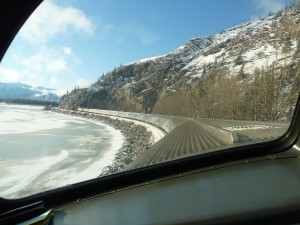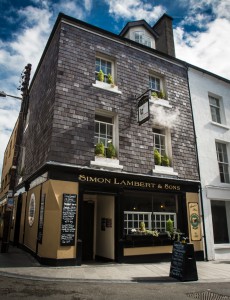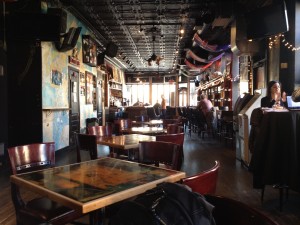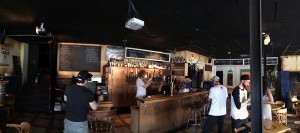
The VIARail Canadian makes a short smoke stop in Hornepayne. The rearmost car on the train is a historic observation lounge dome car, which is for exclusive use of the bedroom passengers.
November is right around the corner, and it’s time to start thinking about a winter getaway. Like most college teachers I know, I get a few weeks break at the end of the year, and it turns out that this is a really good time to take a trip.
Winter travel has some important disadvantages. Snowstorms can close airports, and trains and planes can get canceled due to bad weather. Your suitcase will contain cold weather clothing and will be bigger and heavier than a summer weekend bag. The days will be short– if you head to places north of the United States (Northern Canada or UK, for instance), the sun won’t rise until after 8 am, and it will be dark by 5. The biggest negative is the weather– all my favorite destinations tend to be cold and rainy in the winter months. Even places like Southern California and New Orleans have winter rainy periods.
On the positive side– few people are vacationing. The lines at the attractions will be short, frequently the prices will be lower (sometimes a lot lower), and you’ll have no problems finding seats on trains and plane, and rooms in your favorite country inns.
Suggestions for train fans:
Ride the VIARail Canadian across Canada.

Going through the Canadian Rocky Mountains as seen from the dome car. Typically, the wintertime Canadian train has three sleepers, two dome cars, two coaches, a dining car and a baggage car.
The Canadian is Indisputably the poshest regularly scheduled train ride in North America. It’s a three-day, four-night trip that runs between Toronto and Vancouver and offers passengers a choice of traveling by coach, or in open section, or bedroom accommodations. The 1950s-era train set is modern and comfortable inside, and has two dome cars. Sleeper tickets include all meals, and exclusive access to the Park Car at the tail end of the train.
Buying a ticket is easy — every Tuesday, VIA releases some tickets at 40% discount: http://www.viarail.ca/en/fares-and-packages/our-lowest-fares
Getting from New York City to Toronto is pretty easy either on Amtrak, or on a convenient flight from Newark Airport into Billy Bishop Airport on Porter Airlines (Billy Bishop is at the foot of Bathurst St, and there’s a free connecting bus to the train station).
Take the Amtrak Southwest Chief to sunny Arizona or New Mexico.
Unfortunately, Amtrak doesn’t do seasonal sales like VIARail, but connecting airlines (particularly Southwest Airlines) offer significant discounts should you opt to fly in one direction. Arizona and New Mexico have longer winter days what we experience in the more northern cities. It will be cold in the Southwest (30-40 degrees in the daytime), but it should be mostly sunny.
Visiting the Grand Canyon, Santa Fe or Taos is great in the winter. Hotels offer discounted off-season pricing and there are is no waiting in lines to see anything. Staying inside Grand Canyon National Park at one of the historic hotels is pricey with limited availability in the summer, but there’s a lot of discounting in the winter months: http://www.grandcanyonlodges.com/dealsandpackages/escapepkg16

An official photo of El Tovar Hotel at the south rim of the Grand Canyon (photo provided by Xanterra–the operator of the historic Grand Canyon hotels).
Amtrak serves the Grand Canyon from it’s Williams Junction station. You can change there to the Grand Canyon Railway https://www.thetrain.com/the-train/schedule-routes/, or a hotel shuttle to complete your trip to the hotels at the South Rim of the canyon. (Important note– Amtrak doesn’t stop at the old downtown Williams station where the Grand Canyon Railway is based, you will need to ride the connecting bus between the Amtrak Williams Junction station to Williams–it’s a three mile ride, see the link above for more information.) The closest airport is Flagstaff, and there’s $25 shuttle that will take you there from the South Rim http://canyonshuttle.com/. American Airlines serves Flagstaff with $129 one-way trips from Newark Airport. You may find better deals flying through Phoenix, which is more than three hours away, and you’re likely to need to rent a car to get there, so it will be hardly a deal when all expenses are considered. (The Grand Canyon is remote, and surprisingly, it’s easier to get there by train than plane.)
In Santa Fe, the historic La Fonda hotel offers attractive discounted rates (sometimes as much as 50% off) in the winter months. Built in the early 1930s by the Santa Fe Railway, La Fonda was tastefully updated a few years ago, and retains much of the early “Indian Detours” ornamentation from it’s early days as a tourist hotel. Rooms on the second floor have working fireplaces, and the large Mary Louise Colter-designed lobby has several large hearths that call out to wintertime visitors. While in Santa Fe, you’ll probably want to rent a car for a day or two (there’s a car rental office next to the hotel) to visit Taos and the Pueblos which are north of town. http://www.lafondasantafe.com/specials/bed-breakfast-package
Santa Fe can be reached by Amtrak from either the Lamy station (Amtrak offers a shuttle bus for the 20 minute connecting trip), or by commuter train from the Albuquerque Amtrak Station. There is frequent bus service from the Albuquerque train station to the city airport, which is well-served by Southwest Airlines.
Take Amtrak’s California Zephyr to San Francisco.

Close to the Amtrak Oakland station, the Oakland BART station, and the Transbay ferry, the Waterfront Plaza Hotel makes for a convenient home base when visiting the San Francisco Bay Area.
January is San Francisco’s rainiest month, but it seldom gets below 50 degrees. San Francisco tends to be a good city for low-priced winter fares, and off-season hotel prices. One suggestion– stay in Oakland, and take the BART train or the ferry into town to do your sightseeing. Amtrak’s station for the city is at Jack London Square in Oakland–there’s a few excellent hotels close to the station, and frequent ferry service to downtown. The Waterfront Hotel is always a good bet, and they offer off-season deals. http://www.jdvhotels.com/hotels/california/san-francisco-hotels/waterfront-hotel/
Oakland’s airport is nearby, and is competitively served by Virgin America, Southwest and United–$150 one-way flights from Newark Airport on some days.
Pick up a rental car or shuttle in Miami, and motor to Key West.
Key West is the chillest spot in Florida, also the most southern. It’s laid-back, walkable downtown, full of museums, great eating spots, and interesting shopping makes for a perfect wintertime rest.





































